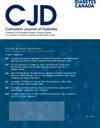斋月对非禁食型 1 型糖尿病患者体育活动障碍、睡眠模式和体能的影响。
IF 2.3
4区 医学
Q3 ENDOCRINOLOGY & METABOLISM
引用次数: 0
摘要
目的:本研究旨在探讨 1 型糖尿病(T1D)非禁食患者在斋月期间的睡眠模式、体能和体育锻炼(PA)障碍 方法:61 名非禁食的 1 型糖尿病患者(29 名女性,32 名男性)完成了斋月前和斋月期间的问卷调查,其中包括体育锻炼障碍(BAPAD1)、匹兹堡睡眠质量指数(PSQI)和国际体育锻炼问卷(IPAQ)等评估:结果:在斋月期间,BAPAD1 的得分没有显著增加(P=0.378)。主要障碍包括低血糖风险、工作时间安排、糖尿病控制和疲劳。PSQI 分数显著增加(P=0.378):斋月活动并不影响 T1D 患者的体育锻炼障碍,尽管睡眠模式和体育锻炼方式有所改变。斋月活动引起的生活方式改变对未禁食的 T1D 患者有很大影响,导致体育锻炼减少、睡眠时间缩短和久坐时间增加。本文章由计算机程序翻译,如有差异,请以英文原文为准。
Ramadan-Induced Lifestyle Changes: Effects on Sleep and Physical Activity in Nonfasting Individuals With Type 1 Diabetes
Objectives
In this study, we aimed to identify sleep patterns, physical fitness, and barriers to physical activity (PA) during Ramadan observance in a cohort of nonfasting individuals with type 1 diabetes (T1D).
Methods
Sixty-one nonfasting individuals with T1D, age 28.34±9.43 years (ranging from 15 to 54 years), completed questionnaires before and during Ramadan. The questionnaires included 3 assessment instruments: the Barriers to Physical Activity in Type 1 Diabetes (BAPAD1), the Pittsburgh Sleep Quality Index (PSQI), and the International Physical Activity Questionnaire.
Results
During Ramadan, there was no significant change in BAPAD1 scores compared to before Ramadan (p=0.378). The primary barriers encompassed hypoglycemia risk, work schedules, diabetes control, and fatigue. Moreover, subjective sleep quality deteriorated during Ramadan compared to the pre-Ramadan period (p<0.001). Sleep duration decreased by 58 minutes (p<0.01) and was associated with later bedtimes and more awakenings. There was a notable decrease in PA levels (p=0.042), particularly for vigorous activities (p=0.017), whereas sedentary time showed a significant increase (p=0.008).
Conclusions
Ramadan observance did not affect barriers to PA in individuals with T1D despite alteration of sleep patterns and PA levels. Lifestyle alterations associated with Ramadan observance significantly impact individuals with T1D who are not fasting, resulting in reduced PA, shortened sleep duration, and increased sedentary time.
求助全文
通过发布文献求助,成功后即可免费获取论文全文。
去求助
来源期刊

Canadian Journal of Diabetes
ENDOCRINOLOGY & METABOLISM-
CiteScore
4.80
自引率
4.00%
发文量
130
审稿时长
54 days
期刊介绍:
The Canadian Journal of Diabetes is Canada''s only diabetes-oriented, peer-reviewed, interdisciplinary journal for diabetes health-care professionals.
Published bimonthly, the Canadian Journal of Diabetes contains original articles; reviews; case reports; shorter articles such as Perspectives in Practice, Practical Diabetes and Innovations in Diabetes Care; Diabetes Dilemmas and Letters to the Editor.
 求助内容:
求助内容: 应助结果提醒方式:
应助结果提醒方式:


